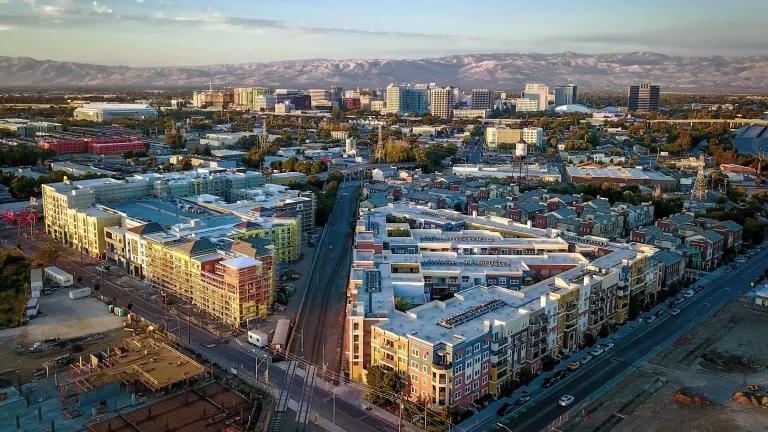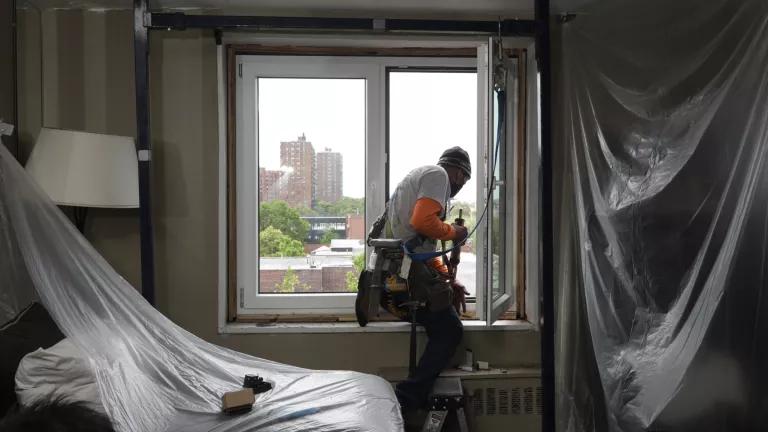
Part of NRDC's Year-End Series Reviewing 2019 Climate & Clean Energy Developments
As 2020 begins, so does an era of clean, efficient buildings in states across the country, thanks to strong beneficial electrification policies passed last year in California. The movement toward all-electric new construction has been swift. Less than six months ago, Berkeley, CA, passed the nation's first all-electric new building ordinance.
In the short period since, two dozen California cities have followed suit with strong building codes and other local ordinances aimed at cutting fossil fuel pollution from homes and businesses, and several dozen others are working on similar actions to promote clean electric new buildings.
These city-level policies complement California’s updated statewide building code effective January 1 requiring all new single-family homes and low-rise apartment buildings to install solar panels or tap into community solar power. The goal is to wean buildings off fossil fuel pollution and make the places we live and work in healthier, safer, and more affordable.
California is not alone in taking action in the face of federal policy inaction and even regression: New York City's Local Law 97, enacted last May, assigns an annual emissions cap for 50,000 buildings starting in 2024. A new policy in Seattle provides incentives for homeowners to replace oil heating systems with clean and efficient electric heat pumps. And 25 large cities across the country are stepping up to meet Paris climate goals as part of the American Cities Climate Challenge.
States such as Maine and Massachusetts are also moving toward building electrification by encouraging the adoption of heat pumps, and a handful of other states, including New York and Rhode Island, are beginning to recognize the importance of building electrification as they draft climate and energy plans.
Fossil Fuel Industry Misinformation Campaign
The fossil fuel industry and its backers are not going quietly: they reacted quickly to this emerging threat to their business model that depends on keeping people locked into their products and charging them for the ever-increasing cost of building unnecessary pipelines. Already, lawsuits have been filed to fight ordinances in Berkeley and Windsor, and the industry is pushing the adoption of so-called "energy choice" resolutions to try and stall the spread of electrification policy. They’re using the tried and tested playbook of the tobacco and other declining industries before them: delay action as long as possible by scaring and confusing the public, spreading misinformation on costs, and putting up a green smokescreen.
They are using outdated information to claim that electric appliances cost more, and that biogas will somehow, one day, solve all our pollution woes. These cost claims are based on old technology rather than today’s modern electric heat pump and induction technology that is 3 to 5 times more efficient than gas appliances, using only a fraction of the energy.
And never mind that biogas represents less than 1 percent of the gas used in buildings today, that there likely won’t ever be enough of it to power more than a small fraction of the current uses of gas, and that it is cost-prohibitive. In contrast, more than 50 percent of California’s electricity is already carbon-free today with legal requirements for 100 percent by 2045, and producing electricity from solar and wind energy now costs less than from gas power plants.
Never mind also that biogas doesn’t have any of the health benefits of clean electricity, and its climate benefits are overstated as leakage of unburnt methane from production, distribution pipes, meters, and burners, whether from fossil or bio sources, is a key contributor to the climate crisis.
New Buildings Are the Obvious Place to Start
But climate-aware consumers and policymakers know too much is at stake to keep constructing new buildings that depend on an antiquated and polluting energy source, locking them into decades of higher costs and pollution. New buildings are the obvious place to start: all-electric homes cost less and are faster to build than those heated with gas. Relying on efficient, electric-powered equipment avoids the need to install a gas line connection, meter, indoor piping, and venting equipment, saving money and time. Twenty-first century homes and commercial structures need to be built for the clean energy future that is advancing rapidly with every new solar panel and wind turbine.
An all-electric building provides affordable, safe comfort for decades to come. Shielded from skyrocketing gas prices, residents of all-electric buildings (particularly those with solar panels) will tend to see lower ongoing costs. Using highly efficient heat pumps instead of gas furnaces and water heaters, for example, would reduce annual utility bills in existing residential dwellings by $300 in multifamily, and up to $750 in single-family homes, and $100- $200 in new homes. Residents of all-electric homes also breathe healthier indoor air by avoiding toxic combustion gases from gas stoves, furnaces, and water heaters.
These benefits for residents accompany the reality that we can no longer ignore buildings as a significant source of emissions that are fueling the climate crisis. Beyond the carbon associated with burning fossil fuels in the buildings themselves, shoring up demand with new gas-fueled construction enables massive pollution upstream in the form of ongoing, ignored methane leaks at processing facilities or catastrophes like the one at the Southern California Aliso Canyon storage facility. As coal declines, gas is now driving most of the carbon emissions growth worldwide. Every new building with a gas line helps cement this trend.
To all consumers and policymakers who want healthier, safer, more affordable buildings, and seek to leave better living conditions to future generations, let us build the movement for beneficial building electrification in 2020 and beyond, and plan for an affordable and equitable gas transition in our buildings.



